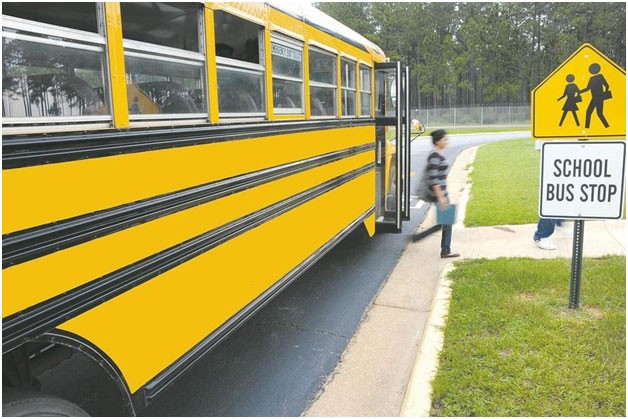
Image by Gerd Altmann from Pixabay
School districts nationwide strive to provide efficient busing services for their students. Every morning, school buses traverse various regions, collecting students from their homes. An area to consider is school start times. Could these start times be contributing to student challenges?

Clinique Somnomed, CC BY-SA 4.0, via Wikimedia Commons
The Science Behind School Start Times
School start times have been a topic of debate for many years, with some experts arguing that starting school later in the day would benefit students' health and academic performance.
Historically, school buses have picked up students early in the morning, sometimes before sunrise. However, the duration of these routes is not solely a measure of their efficiency, as it is also influenced significantly by geography, population density, and school start times. As a result, school administration officers need to evaluate whether this conventional approach meets the needs of all students in their community.
There is a growing body of research that suggests that starting school later in the day can be beneficial for students. For example, a study by the American Academy of Pediatrics found that adolescents who started school later in the day got more sleep, had better grades, and were less likely to be involved in accidents.
There are several reasons why starting school later in the day may be beneficial for students. First, adolescents have a natural tendency to stay up later than younger children and adults. Second, the release of melatonin, a hormone that helps regulate sleep, is delayed in adolescents. This means that adolescents are more likely to be sleepy in the morning if they must wake up early.
Starting school later in the day can help to address these issues by giving adolescents more time to sleep. This can lead to improved mood, cognitive function, and academic performance. It can also reduce the risk of accidents and injuries, as well as problems with attention and behavior.
Of course, there are also some challenges associated with starting school later in the day. For example, it can make it more difficult for parents to get their children to school on time. It can also create scheduling conflicts with extracurricular activities.
Despite these challenges, the research suggests that the benefits of starting school later in the day outweigh the drawbacks. School administration officers should carefully consider the needs of their students and community when making decisions about school start times.
Adolescent Sleep Patterns
Adolescents have a natural tendency to stay up later and sleep in later than younger children and adults. This is due to several factors, including changes in their circadian rhythm (the body's natural sleep-wake cycle) and the release of melatonin, a hormone that helps regulate sleep.
Prior to puberty, children naturally feel sleepy around 8:00 or 9:00 pm. However, as they transition into their teenage years, their bedtime typically shifts to around 10:00 or 11:00 pm. This shift in sleep-wake patterns is perfectly normal and healthy for adolescents.
However, the early school start times that are common in many school districts can make it difficult for adolescents to get enough sleep. If an adolescent has to wake up at 6:00 am for school, they will only get 6.5 to 7.5 hours of sleep if they go to bed at 10:00 pm. This is less than the 8 to 10 hours of sleep that adolescents typically need.
Lack of sleep can have several negative consequences for adolescents, including:
- Impaired cognitive function. Adolescents who don't get enough sleep are more likely to have difficulty paying attention, learning new information, and making decisions.
- Mood problems. Adolescents who don't get enough sleep are more likely to experience mood problems such as anxiety, depression, and irritability.
- Behavior problems. Adolescents who don't get enough sleep are more likely to engage in risky behaviors such as substance abuse, violence, and unsafe sex.
- Health problems. Adolescents who don't get enough sleep are more likely to experience health problems such as obesity, diabetes, and heart disease.
If you are an adolescent or the parent of an adolescent, it is important to make sure that they are getting enough sleep. Here are a few tips:
- Go to bed and wake up at the same time each day, even on weekends. This will help to regulate your circadian rhythm.
- Create a relaxing bedtime routine. This could include taking a warm bath, reading a book, or listening to calming music.
- Avoid caffeine and alcohol before bed. These substances can interfere with sleep.
- Make sure your bedroom is dark, quiet, and cool. These conditions are ideal for sleep.
- If you can't fall asleep after 20 minutes, get out of bed and do something relaxing until you feel tired. Lying in bed awake will only make it harder to fall asleep.

Image by Peggy und Marco Lachmann-Anke from Pixabay
Consequences of Sleep Deprivation in Teenagers
Sleep deprivation can have a significant impact on teenagers' lives, affecting their mental health, academic performance, and overall well-being.
There are several factors that can contribute to sleep deprivation in teenagers, including:
- Early school starting times. Many teenagers must wake up early in the morning for school, which can make it difficult for them to get enough sleep.
- Use of electronic devices at bedtime. The light emitted from electronic devices can interfere with sleep.
- Caffeinated drinks. Caffeine can make it difficult to fall asleep.
- Demanding homework schedules. Many teenagers face substantial homework loads, potentially impacting their sleep duration. [Source: "Sleep in Adolescents: The Perfect Storm" published in Pediatric Clinics of North America]
The consequences of sleep deprivation in teenagers can be serious, including:
- Difficulty concentrating. Teenagers who are sleep-deprived may have difficulty paying attention in class and completing schoolwork.
- Declining grades. Sleep deprivation can lead to poor grades in school.
- Increased risk of accidents. Teenagers who are sleep deprived are more likely to be involved in accidents.
- Mood problems. Sleep deprivation can lead to mood problems such as anxiety, depression, and irritability.
- Increased risk of substance abuse. Teenagers who are sleep-deprived may be more likely to use drugs or alcohol.
- Increased risk of suicide. Sleep deprivation can increase the risk of suicide in teenagers.
If you are concerned that your teenager is not getting enough sleep, there are a few things you can do:
- Talk to your teenager about the importance of sleep. Explain the risks of sleep deprivation and how it can affect their health and well-being.
- Set a bedtime and wake-up time for your teenager and stick to it, even on weekends. This will help to regulate their circadian rhythm.
- Create a relaxing bedtime routine. This could include taking a warm bath, reading a book, or listening to calming music.
- Encourage your teenager to avoid using electronic devices at bedtime. The light emitted from electronic devices can interfere with sleep.
- Make sure your teenager's bedroom is dark, quiet, and cool. These conditions are ideal for sleep.
- If your teenager is still having trouble sleeping, talk to their doctor. There may be an underlying medical condition that is causing their sleep problems.
The Role of School Bus Routing Software in Striking a Balance Between Meeting Student Needs and Optimizing Route Efficiency
School bus routing software is a powerful tool that can help schools strike a balance between meeting student needs and optimizing route efficiency. This software aggregates data, from student demographics to fleet details, to facilitate the generation of potential routes. Given the numerous variables at play, such as changing weather conditions, bus malfunctions, or calendar alterations, this software becomes instrumental in making real-time adjustments to bus schedules.
Here are some of the specific ways that school bus routing software can help schools:
- Meet student needs: School bus routing software can help schools to ensure that all students have access to transportation, regardless of their location. The software can also be used to create routes that minimize the walking distance for students, which can be especially beneficial for students with disabilities.
- Optimize bus capacity utilization: School bus routing software can help schools to optimize their bus routes by making the best use of the available seating capacity on the bus. This can save schools money on fuel costs, reduce traffic congestion, and help to ensure that all students have a seat on the bus.
- Use ridership data to reduce overcrowding: School bus routing software can be used to analyze ridership data to identify areas where buses are overcrowded. This information can then be used to adjust bus schedules and routes to reduce overcrowding and ensure that all students have a comfortable and safe ride.
Overall, school bus routing software is a valuable tool that can help schools to improve the efficiency and safety of their bus transportation system. By using this software, schools can ensure that all students have access to transportation and that bus routes are optimized to minimize the amount of time that buses spend on the road. This can save schools money, reduce traffic congestion, and improve the safety of students.
Enhancing Transportation Efficiency with Bus Routing Software
Bus routing software consolidates vital data into a unified database, including student demographics from information systems and comprehensive fleet data. With this collective information at hand, the system can devise potential routes. Various factors, including student movement between districts, unpredictable weather, and bus issues, can necessitate route adjustments during the year. This software's real-time data handling capability ensures that all these variables are duly considered.
Here are some of the specific ways that bus routing software can enhance transportation efficiency:
- Reduce the number of drivers required: By optimizing bus routes, bus routing software can help districts to reduce the number of buses that are needed to transport students. This can save money on labor costs and can also help to address the nationwide driver shortage.
- Plan routes that meet the needs of all students: Bus routing software can be used to plan routes that minimize the walking distance for students and avoid unsafe areas, while also considering the needs of students with disabilities and other special needs.
- Provides real-time updates on bus locations. Bus routing software can provide real-time updates on bus locations, which can help parents and students to track the progress of buses and to plan accordingly.
- Allows for adjustments to bus routes. Bus routing software can be used to make mid-year adjustments to bus routes in response to changing conditions. For example, if there is a storm that causes road closures, the software can be used to reroute buses or to send a message to the students on the bus to let them know of the change.
Overall, bus routing software is a valuable tool that can help schools to improve the efficiency and safety of their bus transportation system. By using this software, schools can reduce the number of buses that are needed, minimize the walking distance for students, provide real-time updates on bus locations, and make mid-year adjustments to bus routes in response to changing conditions. This can save money, reduce traffic congestion, and improve the safety of students.

Image by David Mark from Pixabay
Optimizing Routes to Improve Timing and Efficiency
School districts can use advanced routing software to modify routes quickly and easily, avoiding the need for tedious manual recalculations. This software can consider a variety of factors, including school start times, student demographics, and traffic conditions.
For example, if a school district decides to change school bell times, the routing software can adjust other parameters accordingly. For instance, to shorten the run time of the bus to fit it in the window of time between school bell times, the walking distance for students to bus stops might be extended slightly, reducing the number of stops overall.
This can save schools time and money, and it can also improve the efficiency of their bus transportation system. By using advanced routing software, school districts can ensure that their buses are running on time and that students are getting to school safely.
Here are some specific benefits of using advanced routing software to optimize bus routes:
- Improved timing: Advanced routing software can help to ensure that buses arrive at their destinations on time, even when there are changes to the schedule. This can help to reduce student tardiness and improve the overall efficiency of the school day.
- Increased efficiency: Advanced routing software can help to reduce the number of buses that are needed, which can save money on fuel costs and reduce traffic congestion.
- Improved safety: Advanced routing software can help to identify and avoid dangerous areas, which can help to keep students safe.
- Reduced stress for parents and students: Advanced routing software can provide parents and students with real-time updates on bus locations, which can help to reduce stress and anxiety.
Overall, advanced routing software is a valuable tool that can help school districts to improve the efficiency and safety of their bus transportation system. By using this software, school districts can save time and money, improve student safety, and reduce stress for parents and students.
The Impact of School Start Times on Transportation
Adjusting school start times can be a potential solution to certain transportation inefficiencies, but it is important to consider several underlying factors before making changes. Current early start times impact not only student health but also the overall efficiency and safety of bus routes. Running buses before daylight, especially during the winter, can pose safety risks. Traffic congestion during peak commute hours can also introduce further inefficiencies. Bus monitoring can provide insights into wait times, fuel consumption, and potential route issues, suggesting areas for improvement.
Here are some of the specific factors to consider when adjusting school start times:
- Student health: Early start times can disrupt students' sleep patterns, which can lead to fatigue, decreased academic performance, and mood problems.
- Bus safety: Running buses before daylight can pose safety risks, especially in rural areas or during the winter months. Bus routing software can help to mitigate these risks by designing routes that avoid hazardous areas, such as dark or unlit roads. Software can also be used to identify and prioritize stops that need to be well-lit and have safe pedestrian access.
- Traffic congestion: Starting school later in the day can help to reduce traffic congestion, which can improve the efficiency of bus routes.
- Bus monitoring can provide insights into wait times, fuel consumption, and potential route issues, which can help to improve the efficiency and safety of bus transportation. Bus routing software can also be used to create routes that take into account different school start and dismissal times, as well as the needs of students with different after-school activities and commitments.
By considering all these factors, school districts can make informed decisions about school start times that will benefit students, staff, and the community.
Staggered School Start Times: Improving Efficiency and Equity
Staggered school start times can be a solution to improve the efficiency of bus fleets and reduce the overall number of buses needed. By starting different schools at different times, the same buses can be used to service multiple routes, leading to potential cost savings.
However, it is important to note that staggered school start times should not be implemented solely for the purpose of reducing costs. It is crucial to consider the impact on all stakeholders, including students, families, staff, and the community.
Students may be disadvantaged by staggered school start times if they are forced to wake up earlier or stay up later than they would otherwise. This can lead to sleep deprivation, which can have a negative impact on academic performance, health, and well-being. Additionally, staggered school start times can make it difficult for students to participate in extracurricular activities or work after school.
Families may also be disadvantaged by staggered school start times if they have children at multiple schools with different start times. This can make it difficult for parents to get all of their children to school on time and to coordinate work and childcare schedules.
Staff may also be disadvantaged by staggered school start times if they work at multiple schools with different start times. This can lead to longer workdays and increased stress levels.
The community may also be disadvantaged by staggered school start times if they lead to increased traffic congestion and/or reduced parking availability.
It is important to carefully weigh the pros and cons of staggered school start times before deciding about whether or not to implement them. Automated routing software can be used to help school districts design staggered school start times that minimize the negative impact on all stakeholders.
For example, routing software can be used to create schedules that consider the needs of students who participate in extracurricular activities or who work after school. Routing software can also be used to create schedules that minimize travel times and reduce traffic congestion.
Overall, staggered school start times can be a valuable tool for improving the efficiency of bus fleets and reducing costs. However, it is important to implement them carefully and to consider the impact on all stakeholders. Automated routing software can be used to help school districts design staggered school start times that minimize the negative impact and maximize the benefits for all.
Staggered school start times can offer several benefits, including:
- Improved efficiency: Staggering start times can help schools save money on labor costs and address the nationwide driver shortage by reducing the number of drivers needed.
- Increased equity: Staggered start times can ensure that all students have access to transportation, regardless of their location, which is especially important for students in rural areas or who have to travel long distances to school.
However, staggered school start times also have some potential drawbacks, such as:
- Disruption to family routines: Staggered start times can disrupt family routines, especially for working parents with multiple children who attend different schools.
Overall, staggered school start times can be a viable option for improving the efficiency and equity of bus transportation, but only if the financial and resource (driver) availability allows. Ultimately, the decision of whether or not to implement staggered school start times is a political one that is influenced by a variety of factors, including community support.
In addition to the benefits and drawbacks mentioned above, it is also important to consider the following factors when evaluating staggered school start times:
- The needs of students: The needs of students should be the top priority when considering staggered school start times. This includes factors such as sleep patterns, academic performance, and social-emotional well-being.
- The needs of families: The needs of families should also be considered when evaluating staggered school start times. This includes factors such as work schedules, childcare arrangements, and transportation options.
- The needs of the community: The needs of the community should also be considered when evaluating staggered school start times. This includes factors such as traffic congestion, air quality, and noise pollution.
By carefully considering all these factors, school districts can make informed decisions about staggered school start times that will benefit students, families, and the community.

Image by ken19991210 from Pixabay
The Link Between Sleep, Academic Performance, and Safe Transportation
The importance of sleep for students has been well-established, with research highlighting its impact on cognitive function and overall academic performance. Sleep deprivation can impair attention, memory, and problem-solving skills. Additionally, a lack of rest can lead to emotional difficulties, affecting a student's overall experience in the educational setting.
While research highlights the sleep requirements of adolescents, school start times haven't consistently reflected these findings. This can lead to students waking up early and not getting enough sleep, which can have several negative consequences. [Source: American Academy of Pediatrics - "School Start Times for Adolescents"]
For example, sleep deprivation can lead to:
- Reduced attention and concentration: Students who are sleep deprived may have difficulty paying attention in class and completing assignments.
- Impaired memory: Sleep deprivation can make it difficult for students to remember information that they have learned.
- Slow reaction time: Sleep deprivation can make it difficult for students to react quickly to changes in their environment, which can increase the risk of accidents.
- Mood problems: Sleep deprivation can lead to mood problems such as anxiety and depression.
In addition to the academic consequences, sleep deprivation can also have a negative impact on student safety. For example, students who are sleep-deprived may be more likely to engage in risky behaviors such as texting while driving or walking home alone at night.
School districts should consider the link between sleep, academic performance, and safe transportation when making decisions about school start times. By starting school later in the day, students can get the sleep they need to be successful in school and stay safe.
Prioritizing Outcomes: Evaluating the Trade-offs
When determining bus routes, the main priority significantly influences subsequent decisions. School districts that focus on cutting costs might aim to minimize the number of operational school buses. However, it is important to recognize that every bus incurs maintenance expenses and the salary of a qualified driver. Using fewer buses can lead to cost savings, but it may also mean that students must walk, or bike longer distances to get to school, which can be inconvenient and unsafe.
Conversely, if the emphasis is purely on efficiency without considering other factors, districts might mistakenly believe that increasing the number of routes will lead to better service. However, it is important to understand that efficiency is about maximizing the number of students transported within given parameters, such as budget, staffing, and time constraints. Increasing the number of routes without careful planning can lead to a number of problems, including longer wait times for students, increased traffic congestion, and decreased efficiency.
Ultimately, the best bus routes are those that strike a balance between cost, efficiency, and student needs. Districts should carefully consider all of these factors when making decisions about bus routes.
Here are some specific factors to consider when prioritizing outcomes for bus routes:
- Cost: Bus routes should be cost-effective, considering the cost of buses, drivers, and maintenance.
- Efficiency: Bus routes should be efficient, transporting the maximum number of students within a given time frame.
- Student needs: Bus routes should meet the needs of students, including their safety, convenience, and access to school.
- Community impact: Bus routes should consider the impact on the community, including traffic congestion, air quality, and noise pollution.
By carefully considering all these factors, school districts can prioritize outcomes for bus routes that benefit students, families, and the community.

Image by Miku Aalto from Pixabay
Lessons and Best Practices for Bus Routing
The experiences of different schools underscore that, with effort and adaptability, educational institutions can navigate the intricacies of bus routing. Addressing inefficiencies can lead to monetary savings, but it is also possible to consider other important factors, such as school start times and student well-being.
Here are some lessons and best practices for bus routing that can be learned from the experiences of different schools:
- Use technology to your advantage. There are many software programs available that can help school districts with bus routing. These programs can take into account factors such as student density, traffic patterns, and road conditions to create efficient and safe bus routes.
- Be flexible. Unforeseen challenges can arise in bus routing, underscoring the importance of adaptability. For example, if there is a traffic accident, you may need to adjust routes to avoid the affected area.
- Consider the needs of all students. When creating bus routes, it's important to consider the needs of all students, including those with disabilities and those who live in rural areas. You may need to create special routes for these students to ensure that they have access to transportation.
- Communicate with parents and students. It's important to communicate with parents and students about bus routes. This will help to ensure that everyone is aware of the routes and that there are no surprises.
- Evaluate your bus routes regularly. It's important to evaluate your bus routes regularly to see if they are still efficient and effective. If not, you may need to adjust.
By following these lessons and best practices, school districts can create bus routes that are efficient, safe, and meet the needs of all students.
Conclusion
An increasing number of educational institutions are acknowledging the impact of early school start times on student health and well-being. When defining "optimal" transportation routes, it is critical to consider this alongside other factors such as student density, traffic patterns, and road conditions. Advanced routing software can equip schools with the tools to compute the best solutions tailored to their unique circumstances.
Here are some additional thoughts on the conclusion:
- School start times: Early school start times can disrupt adolescents' sleep patterns and lead to fatigue, which can negatively impact learning and behavior. There is a growing body of research that suggests that delaying school start times for adolescents is beneficial for their health and academic performance.
- Transportation routes: Transportation routes should be designed to minimize the travel time for students, while also considering factors such as student density, traffic patterns, and road conditions. Advanced routing software can help schools to create efficient and safe transportation routes.
- Unique circumstances: Every school district has its own unique set of circumstances, such as the size of the district, the location of the schools, and the demographics of the students. Advanced routing software can be customized to meet the specific needs of each school district.
By considering all of these factors, including the latest research on sleep science, schools can create transportation routes that are optimal for their students and their community. For example, some states, such as California, have mandated that high school students start no earlier than 8:30 AM, which is in line with AAP and CDC guidelines. Other states, such as Florida, are considering similar legislation.
Frequently Asked Questions (FAQs)
1. How can routing software help optimize school start times?
Routing software simplifies the complex task of calculating the most efficient routes. It considers all data, including student locations, available buses, and other relevant factors. Adjusting variables like school start times becomes straightforward, allowing for easy recalculations.
2. What's the ideal school start time considering transportation efficiency?
The optimal time varies per district, influenced by multiple factors like student needs, available routes, regional size, and traffic patterns. Each community must weigh these elements to determine the best fit.
3. How does sleep deprivation affect student performance and safety during transportation?
Research indicates that sleep-deprived students face challenges like reduced concentration, lower grades, and heightened emotional issues. These factors can also influence their safety during transportation, especially if students are drowsy or distracted.
4. Can altering school start times and utilizing routing software enhance outcomes?
By prioritizing later school start times and leveraging routing software, districts can significantly improve both student well-being and transportation efficiency. This combined approach can be a pivotal step in addressing the widespread issue of student sleep deprivation.



